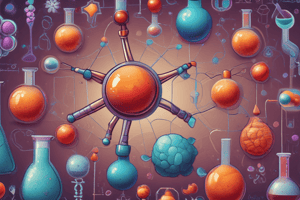Podcast
Questions and Answers
What are the three types of subatomic particles that make up an atom?
What are the three types of subatomic particles that make up an atom?
- Protons, electrons, and neutrons (correct)
- Photons, electrons, and neutrons
- Protons, neutrinos, and electrons
- Positrons, electrons, and neutrons
How many known elements are there?
How many known elements are there?
- 118 (correct)
- 92
- 150
- 64
What determines the atomic number of an atom?
What determines the atomic number of an atom?
- Number of protons (correct)
- Number of neutrons
- Number of electrons
- Number of energy levels
When are molecules formed?
When are molecules formed?
What is a covalent bond?
What is a covalent bond?
What is an ionic bond?
What is an ionic bond?
What is a metallic bond?
What is a metallic bond?
Which subtopic involves exploring the arrangement of elements and their properties in the Periodic Table of Elements?
Which subtopic involves exploring the arrangement of elements and their properties in the Periodic Table of Elements?
What does understanding atoms, elements, and molecules help you gain according to the text?
What does understanding atoms, elements, and molecules help you gain according to the text?
Which type of bond is formed by the attraction between oppositely charged ions?
Which type of bond is formed by the attraction between oppositely charged ions?
What are the three subatomic particles that make up an atom?
What are the three subatomic particles that make up an atom?
Which statement best describes elements?
Which statement best describes elements?
How are molecules formed?
How are molecules formed?
What is the role of electron orbitals in an atom?
What is the role of electron orbitals in an atom?
What is the process known as when molecules are broken down into atoms?
What is the process known as when molecules are broken down into atoms?
What type of bonding involves the sharing of electrons between non-metal atoms?
What type of bonding involves the sharing of electrons between non-metal atoms?
What do intermolecular forces determine about a substance?
What do intermolecular forces determine about a substance?
What results from the rearrangement of atoms and molecules?
What results from the rearrangement of atoms and molecules?
Flashcards are hidden until you start studying
Study Notes
Atoms, Elements, and Molecules: Exploring the Building Blocks of Matter
From the smallest particles to the vast universe, atoms, elements, and molecules form the fundamental basis of chemistry, our world, and everything around us. In this article, we'll delve into the fascinating world of atoms, their elements, and the molecules they create.
Atoms: The Building Blocks of Matter
Atoms are the smallest units of matter that cannot be broken down further without losing their identity. They consist of three types of subatomic particles: protons, neutrons, and electrons.
- Protons: Positively charged particles that are found in the nucleus of an atom. The number of protons in an atom's nucleus determines its atomic number.
- Neutrons: Neutrally charged particles found in the nucleus of an atom. Their presence affects an atom's mass.
- Electrons: Negatively charged particles that orbit the nucleus in energy levels called electron shells or electron orbitals.
Elements: The Chemical Building Blocks
Elements are the basic substances from which all matter is composed. There are 118 known elements, each with their unique atomic number, symbol, and name. Elements can be arranged in a chart called the Periodic Table of Elements, which orders them by their atomic number and physical and chemical properties.
Molecules: The Building Blocks of Compounds
Molecules are formed when two or more atoms bond together. They are the smallest units of a compound that still retain the properties of the compound. Common bonds include covalent, ionic, and metallic bonds.
- Covalent bond: A bond formed when atoms share electrons to achieve a stable electron configuration.
- Ionic bond: A bond formed when atoms transfer electrons to achieve a stable electron configuration, resulting in the formation of oppositely charged ions.
- Metallic bond: A bond formed by the delocalization of electrons in the outermost electron shell of a metal atom, leading to a "sea of electrons" that holds the metal lattice together.
Subtopics
- Atomic Structure: Explore the subatomic particles inside an atom and how they behave within it.
- Periodic Table: Examine the arrangement of elements and their properties in the Periodic Table of Elements.
- Chemical Reactions: Understand how molecules can break apart or join together to form new substances during a chemical reaction.
- Bonding: Explore the various types of bonds that hold atoms together in molecules.
- Molecular Geometry: Discover how the arrangement of atoms in a molecule affects its properties and appearance.
- Intermolecular Forces: Learn about the attractive forces between molecules.
- Chemical Equations: Conquer the basics of balancing chemical equations to show the number of atoms for each element before and after a reaction.
By understanding atoms, elements, and molecules, you'll gain a deeper appreciation for the complex and fascinating world around you, and you'll unravel the mysteries of the chemical and physical interactions that occur every day. With this knowledge, you'll be better equipped to comprehend and explore the intricacies of the universe and the world of chemistry.
Studying That Suits You
Use AI to generate personalized quizzes and flashcards to suit your learning preferences.




